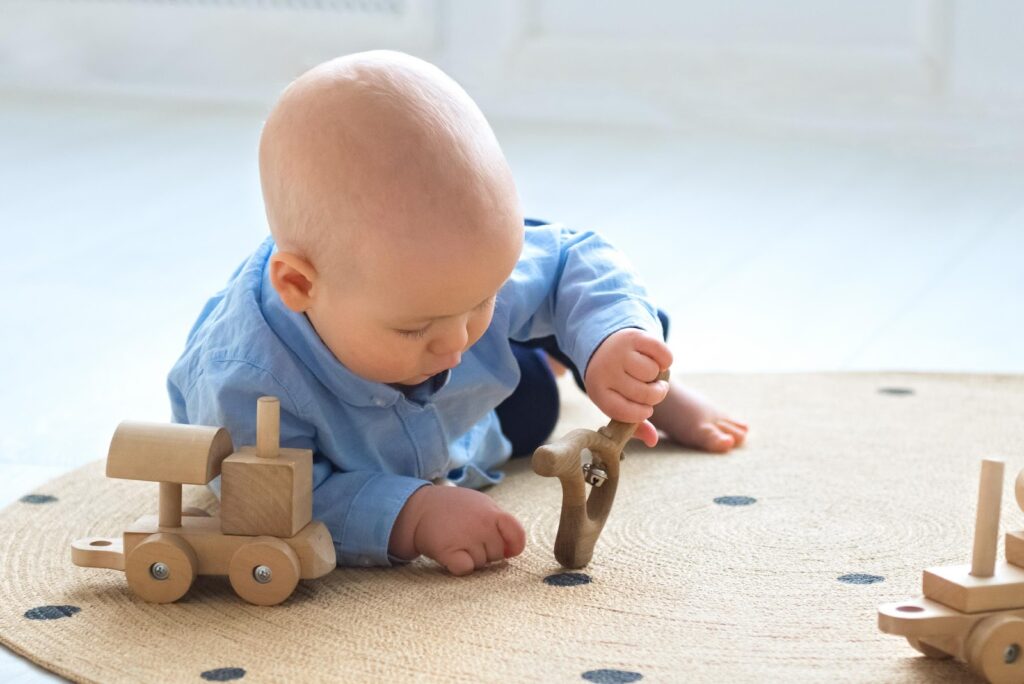How to Treat and Prevent Torticollis and Flat Head in Babies: Tips from a Pediatric Physical Therapist
As a parent, ensuring the optimal growth and development of your baby is a top priority. Two common concerns that parents often encounter are torticollis and flat head syndrome. These conditions can impact your baby’s physical well-being, but the good news is that they are treatable and preventable. In this article, we’ll delve into why these conditions are important to address, along with practical tips, essential positions, effective exercises, and answers to frequently asked questions.
Why is Managing Torticollis and Flat Head Syndrome Important?
Torticollis is a condition where a baby’s neck muscles become tight, leading to limited neck movement. This can cause the baby to favor one side and have difficulty turning their head. On the other hand, flat head syndrome occurs when a baby’s head develops a flat spot due to prolonged pressure on one area, often from lying on their back.
Both torticollis and flat head syndrome can have significant effects on your baby’s overall development. Torticollis can impact their ability to explore their environment and develop important motor skills. Flat head syndrome, if left untreated, can lead to skull asymmetry and potential developmental delays.
What Causes of Torticollis?
Torticollis can have various causes, including:
Congenital Muscular Torticollis (CMT): The most common form of torticollis in infants is CMT. It typically results from tightness or shortening of the sternocleidomastoid muscle,
located on one side of the neck. This may occur due to positioning in the womb, birth trauma, or the baby’s preferred head position during early development.
Positional Plagiocephaly: Positional plagiocephaly, also known as flat head syndrome, can sometimes accompany torticollis. It occurs when the back or side of the baby’s head becomes flattened due to prolonged pressure. This can result from spending excessive time in one position, such as lying on the back or favoring one side.
How Can You Identify Torticollis?
If you suspect your baby might have Torticollis, look for these signs:
- Head Tilt: Observe if your baby consistently holds their head tilted to one side.
- Limited Neck Movement: Check if your baby has difficulty turning their head fully to both sides.
- Preference for One Side: Notice if your baby consistently looks more to one side than the other.
- Flat Head Syndrome: Some babies with Torticollis may develop a flat spot on their headdue to the positioning.
Tips and Tricks for Preventing Torticollis and Flat Head Syndrome
Prevention is key when it comes to these conditions. Here are some valuable tips and tricks to help you ensure your baby’s healthy development:
Tummy Time: Incorporate tummy time into your baby’s daily routine from an early age. This helps develop neck and upper body strength, reducing the risk of torticollis and flat head syndrome.
Change Head Position: Alter the direction your baby faces in the crib each night to prevent them from always turning their head in one direction.
Hold and Carry Alternately: Switch the arm you use to hold and carry your baby. This encourages them to turn their head both ways, preventing favoritism toward one side.
Interactive Play: Engage your baby in play that encourages them to turn their head and follow objects with their eyes.
Avoid Prolonged Restraint: Limit the time your baby spends in car seats, strollers, swings, and other restrictive devices, as they can restrict movement and contribute to flat head syndrome.
Essential Positions to Support Your Baby’s Development
Implementing the right positions in your baby’s daily routine can make a significant difference. Here are five essential positions recommended by pediatric physical therapists:
Tummy Time Play: Lay your baby on their tummy while supervised, allowing them to lift their head, strengthen neck muscles, and improve motor skills.
Supine Play: Place your baby on their back and encourage them to reach for toys in both directions and interact with their surroundings.
Side-Lying: Position your baby on their side during playtime to prevent constant pressure on the back of the head.
Cradle Hold: Hold your baby in your arms with their head resting in the crook of your elbow. This allows for gentle neck stretching and flexibility.
Shoulder Carry: Carry your baby over your shoulder while providing necessary head and neck support.
Effective Exercises and Gentle Massage to Promote Healthy Development
In addition to positioning, specific exercises and gentle massage techniques can aid in treating and preventing torticollis and flat head syndrome. Always consult with your pediatrician or physical therapist before attempting these exercises:
Neck Range of Motion: Gently turn your baby’s head from side to side, holding for a few seconds in each direction.
Midline Play: Place toys within your baby’s line of sight at midline, encouraging them to turn their head and reach for the toys.
Rolling Practice: Assist your baby in rolling from back to tummy and vice versa, promoting balanced muscle development.
Mirror Play: Use a mirror to capture your baby’s attention and encourage them to look at their reflection from different angles.
Gentle SCM Massage: With clean hands, gently massage your baby’s Sternocleidomastoid (SCM) muscle, located on the side of the neck. Use soft circular motions, gradually increasing pressure as your baby gets used to it.
Neck Stretches: Neck stretches are crucial in preventing and treating torticollis. The presence of torticollis often indicates tightness in the neck, so stretching your baby’s neck is very important in reducing the risk of torticollis. Neck tension can also lead to full body tension, so it’s crucial to stretch your baby’s whole body to prevent torticollis and also milestone delays.
Strengthening Exercises: Strengthening your baby’s neck will ensure that the muscles are balanced, and the baby can turn and move the head in all directions equally. This leads to equal distribution of pressure and helps prevent conditions like brachycephaly.
Frequently Asked Questions About Torticollis and Flat Head Syndrome
Q1: When should I start tummy time with my baby? Tummy time can start as early as the first few days of life. Begin with short sessions, gradually increasing the duration as your baby gets stronger.
Q2: Is it normal for my baby’s head to be slightly uneven? Some asymmetry is common, but if you notice a significant flat spot or consistent head tilting, consult your pediatrician or a physical therapist.
Q3: Can torticollis be corrected without medical intervention? In mild cases, consistent repositioning and guided exercises might help. However, it’s important to consult a medical professional for proper assessment and guidance.
Q4: How long should I do exercises with my baby each day? Start with a few minutes of gentle exercises and gradually increase the time as your baby tolerates. Short, frequent sessions are often more effective than longer ones.
Q5: My baby doesn’t seem to like tummy time. What should I do? Make tummy time enjoyable by getting down at eye level, using colorful toys, and providing gentle encouragement.
Q6: Can I use pillows to help my baby stay in a certain position? It’s best to avoid using pillows or cushions under your baby’s head, as they can pose a suffocation risk. Focus on safe and supervised positions.
Q7: Are there any long-term effects of flat head syndrome? Untreated flat head syndrome can lead to lasting skull asymmetry and potential developmental delays. Early intervention is key.
Q8: Will my baby need a helmet if they develop a flat spot? Helmets are often recommended for moderate to severe cases of flat head syndrome. Your pediatrician or specialist can provide guidance based on your baby’s condition.
Q9: Can I do these exercises if my baby has a medical condition? If your baby has any underlying medical conditions, it’s crucial to consult their healthcare provider before attempting any exercises or interventions.
Q10: At what age does torticollis typically improve? With consistent intervention, many cases of torticollis show improvement within the first six months of life. However, each baby’s progress is unique.
Remember, every baby is different, and what works for one may not work for another. It’s always a good idea to seek guidance from your pediatrician or a pediatric physical therapist to ensure you’re providing the best care for your little one’s needs.
In conclusion, taking proactive steps to prevent and treat torticollis and flat head syndrome is vital for your baby’s overall well-being. Through proper positioning, engaging exercises, gentle massage, and consistent attention, you can help your baby achieve healthy



